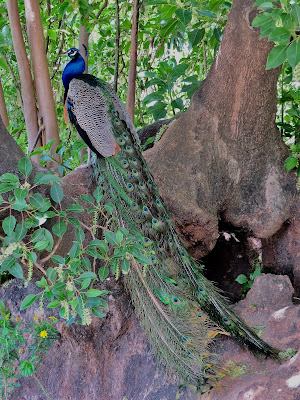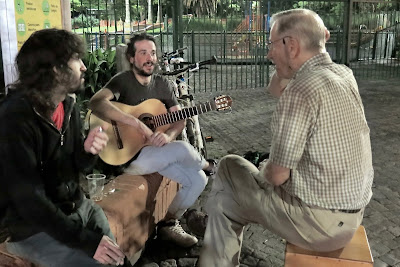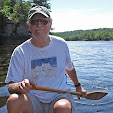(PART THREE OF THREE PARTS / For part one click HERE; for part two click HERE)
ATITLAN
On
my second Friday of school I skip classes, and Amanda and I board a
group shuttle bound for Lake Atitlán. An hour later, after our humorless
driver finally fills 15 of the 14 seats in the van, we actually get out
of Antigua for the two-plus-hour drive west-northwest to the lake.
Lago
Atitlán, widely recognized as one of the most beautiful lakes in the
world, does not disappoint. Formed in the caldera of a mega-volcano that
erupted 84,000 years ago, the 56-square-mile, 1,100-foot-deep lake is
flanked by several 10,000-foot classic, cone-shaped volcanoes.
People
are drawn to Atitlán not just by its stunning beauty, but also by the
area’s reputation as an energy vortex, said to be one of just three such
spiritual hotbeds in the world—along with Peru’s Machu Picchu and
Egypt’s Pyramids of Giza.
More than any "point of interest," any tour,
any photo op, this is the kind of magic that
defines travel for me.
The lake is surrounded by eleven towns and villages, each with its own distinct flavor. Panajachel is the largest, busiest and grittiest, serving as the main road
terminus for all the rest. From there, a busy network of water taxis
connects them all.
San Pedro is known as the backpacker’s mecca, with lots of hostels, clubs and bars and a lively party atmosphere.
San Marcos has a new-age, hippie vibe, with shamans of every stripe, and lots of touchy-feely offerings like yoga, naturopathic foods and drink, healing centers and Reiki and massage parlors.

San Juan is one of the most colorful villages on the lake, with vibrant murals and other public art. Here the Mayan descendants and their Tz’utujil and Kaqchikel cultures are more obvious than in the other villages.
Santa Cruz is a relatively quiet alternative with few conveniences, but superb views of the volcanoes. (This is where Amanda and I stay--at La Arca de Noé, Noah’s Arc, a collection of rooms and separate casitas stair-stepping up the steep hill, some with nice decks overlooking the lake.)

Our last night in Santa Cruz, we tuk-tuk a ways up the steep main street to a small restaurant that someone's recommended. Besides the family that owns it, we have the place to ourselves. Just as we're finishing our meal, we hear the happy birthday song from the other room.
Peeking through the doorway, we see a little girl sitting at the counter with a birthday cake in front of her and the whole family gathered around singing to her. She's eight.
We join in and offer our best wishes to the cumpleañera, and then return to our table. Just as we're asking for the check, one of the kids comes out and shares slices of the birthday cake with us.
More than any "point of interest," any tour, any photo op, this is the kind of magic that defines travel for me.
(I
wish I’d spent more time researching the other villages. If I had, we’d
have known that the gauntlet of commercialism we encounter right off the
boat dock is not the town. To see slices of life like that sweet little birthday party, or public markets, or church services, one has to walk or tuk-tuk a
ways, in some cases nearly a mile, up the steep flank of the caldera
where most Guatemaltecos—and real life—reside. Maybe next time.)
Many people, while chatting within their
families or with fellow workers, speak their
indigenous languages.
MEXICO IT IS NOT
It’s
hard for me, a frequent traveler to Mexico, not to compare Guatemalan
life and culture. The first difference that strikes me is that
Guatemalan culture is far more indigenous. Around 43 percent of the
Guatemalan people are indigenous, while just over 15 percent of Mexicans
are.
While most of Mexico’s pre-colonial roots are Aztec, a warrior
civilization with strong religious and mythological aspects, Guatemala’s
are Mayan, an older, more peaceful, more intellectual culture.
The
currency of these ancient traditions is obvious in people’s dress. At
first I think it’s just the street vendors who wear the
intensely-colored trajes / clothing. But I see many others, including whole families, wearing the striking woven and embroidered cortes / skirts and huipiles / blouses as they walk around town.
 |
| PHOTO: Trama Textiles |
The
colors are amazing. Intense. Each hue and each design element symbolic.
The artisans’ markets are full of the fabrics, fashioned into every
imaginable item, from clothing to table runners to tea cozies to men’s
ties.
Another difference is the language, which I find quite easy
to understand, even when talking with folks on the street. They speak
more slowly and enunciate more clearly than the average José in Mexico.
That said, I observe that many people, while chatting within their
families or with fellow workers, choose to speak their indigenous languages.
Of
course, there are quite a few Spanish words that differ from those used
in Mexico for the same things. Enough for a language learner like me to
get into trouble if he's not careful. But I get through my visit to this enchanting country without exclaiming to
anyone that I’m pregnant (embarazado), as I once did in Mexico.
Pretending to understand any culture
based on seeing just small parts of it is
pure hubris.
JUST A TASTE
I'll never forget a friend's slide show I once viewed. He'd just returned from a ten-day trip to Kenya. His narration was full of conclusions like, "Africa is..." and "Africans are this or that." And it struck me as so presumptuous.
Pretending to understand any country, any culture, based on a vacation, or on seeing just small parts of it, is pure hubris.
So, as
I continue chipping away at my goal of visiting every Spanish-speaking
corner of Latin America, I’m glad to check off Guatemala. The places I saw are lovely; the people I met are kind and generous. But all I can really say is that I've tasted it; I've sampled a few of its many flavors; and I leave hungry for more.
(FOR SLIDE SHOW CLICK HERE)




















































